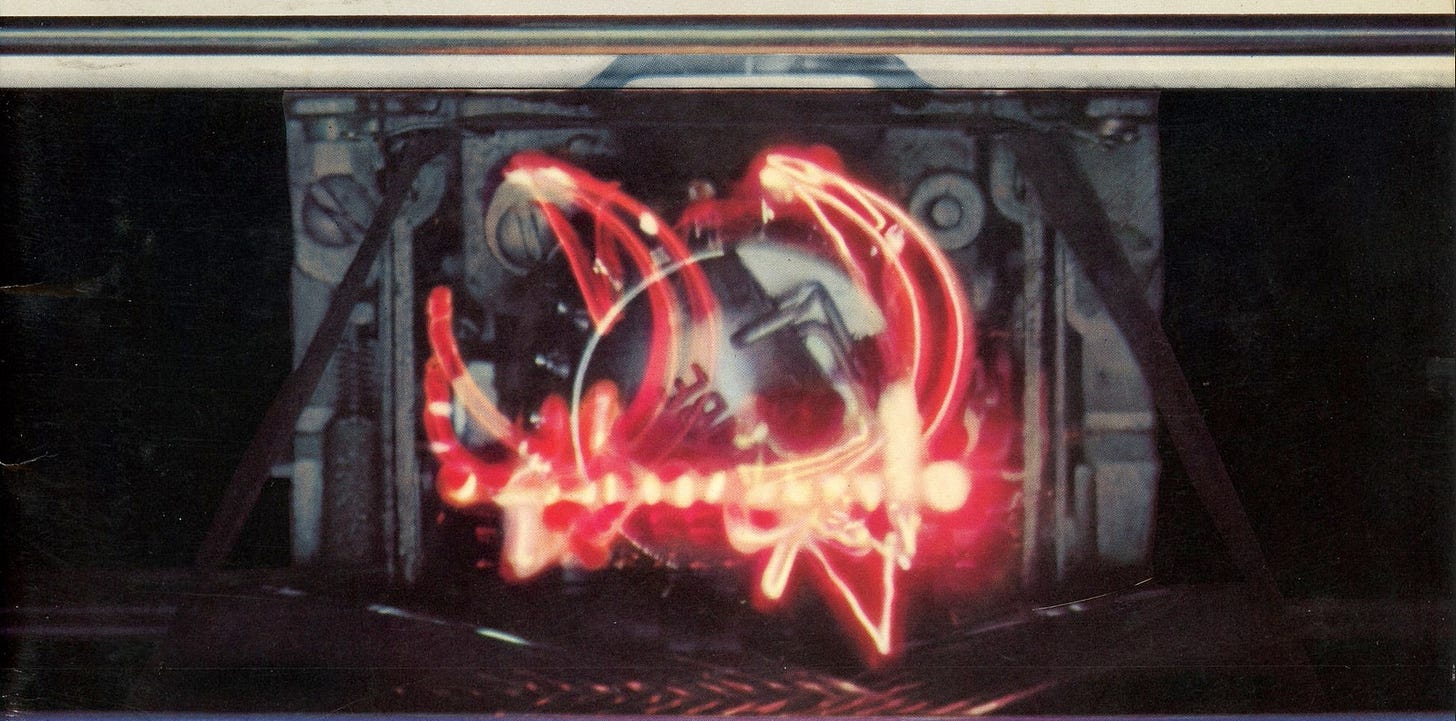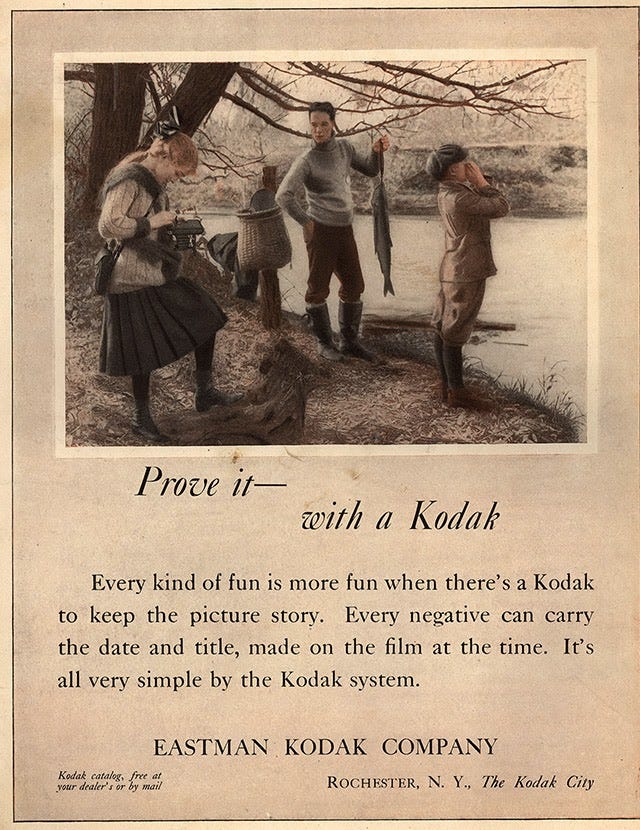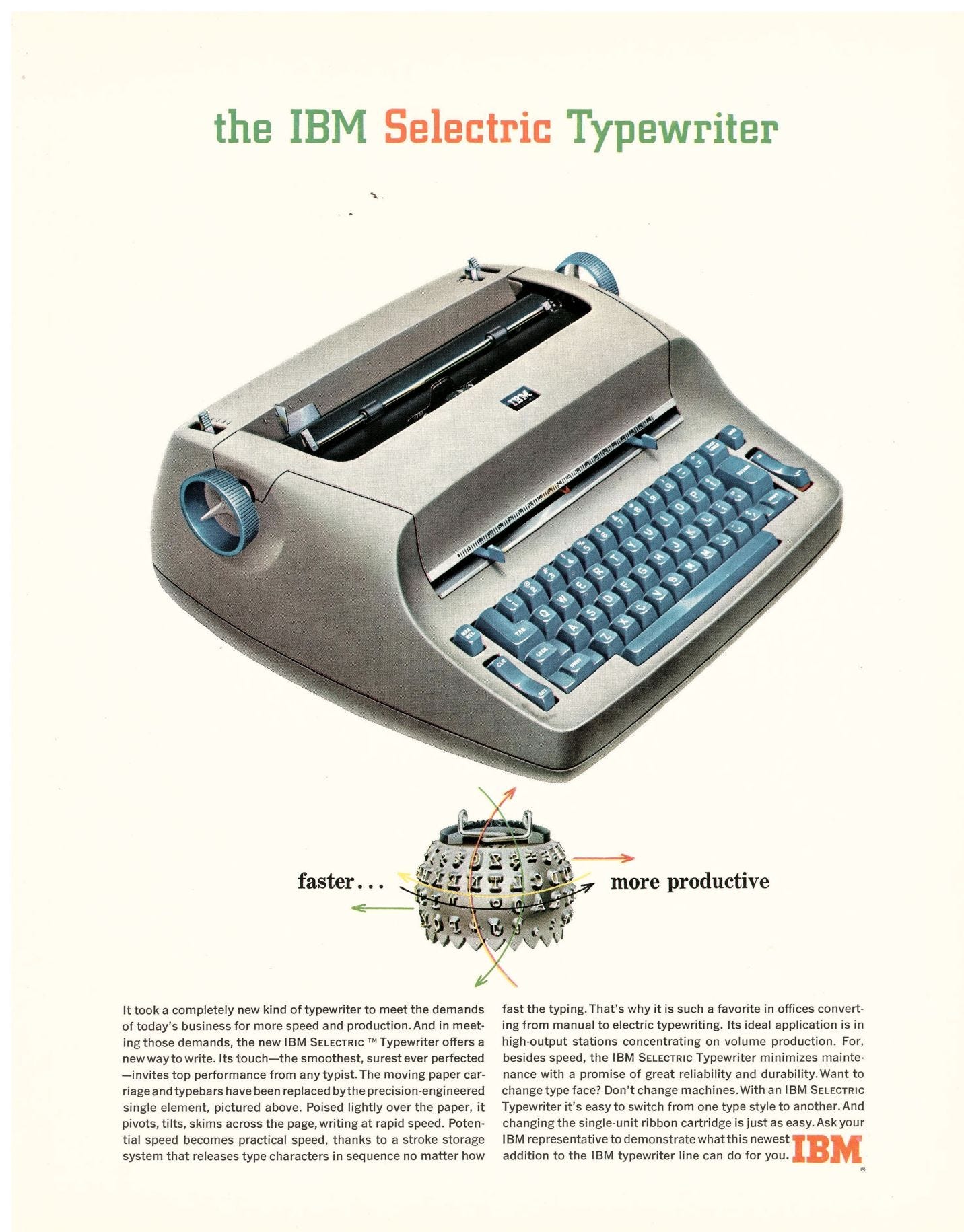
There are innumerable examples of companies and entire industries that were so dominant, so entrenched in the daily lives of its customers, that at the time it was impossible to imagine a world without them or their products. Yet despite the appearance of permanent dominance, many companies and products have eventually disappeared (in the worst/best cases) or just shrunk to insignificance (in the best/worse cases).
This blog is the first part of a three-part series on IBM’s typewriter division. IBM acquired its way into the typewriter business back in 1933. It then applied its growing financial and engineering resources into developing what would become the most successful and dominant electric typewriters in the world, namely the Model 01 in the 1930s and then the Selectric in 1961. The Selectric was a runaway hit when it was released in the summer of 1961, blowing away IBM’s own internal sales projections. It then poured on continual innovations and features over the next two decades to cement a market share of over 80% by the late 1970s. But extraordinarily fast advances in technologies happening in the market for personal computers in the early 1980s all but sealed the fate of the Selectric and the entire typewriter industry.
But first, I want to set the stage with a few other examples of how dominance—or even illegal monopolization—by a firm is rarely ever permanent in a capitalist, free-market society.
Cameras, Blackberries, & Ice
For example, there’s Kodak that innovated continuously and aggressively managed its business over the long term. Founded in the late 19th century, it cemented its dominance, decade after decade. Its Brownie camera came out in 1900. The camera itself sold for $1 and a roll of film cost 15 cents. A super affordable camera and film opened an enormous market for Kodak. The company continually gained market share such that by the 1970s it would control 95% of the film market and 85% of the camera market in the United States.
One of Kodak’s only worthy challengers would be Edwin Land’s Polaroid Corporation which came out with their first instant camera in 1948. Much later in 1976, Polaroid sued Kodak for patent infringement, which would be the beginning of one of the most significant and protracted patent litigations in history. The courts eventually ruled in favor of Polaroid, that Kodak had infringed on its patents. The result was Kodak paying an enormous fine and exiting the instant camera market.
Next, Japanese competition came in the 1980s and waged a successful price war against Kodak. Then the shift to digital photography proved too much for Kodak to handle and it filed for bankruptcy in 2012. Polaroid was unable to find success beyond instant cameras and it filed for bankruptcy in 2001, eleven years before Kodak did the same.
Another more modern example of a product experiencing an even more rapid cycle from nothing to dominance and back to nothing, is Research in Motion (RIM). This company was best known for dominating the early smart phone market with its BlackBerry device. After the introduction of the first BlackBerry in 1999, users eventually became so hooked that they graced it with the narcotic nickname of “Crackberry”. It’s share of the U.S. domestic smart phone market eventually peaked in 2009 at 56%. But even despite a user base that jokingly admitting to an addiction to checking and sending messages, the BlackBerry (and many other smart and dumb phones) eventually ceded the market to Apple’s iPhone. RIM’s co-founders were famously dismissive of the iPhone’s touch screen and form factor. From a position of power and an unbroken track record of success, they could not imagine the iPhone might be a better product that could usurp their position.
My third and final example of what I think is the inevitable ebb and flow from dominance to obsolescence for all products and industries brings us way back to the late 19th and early 20th century. There was once a time when ice was harvested from rivers and lakes in the winter, and then stored, so it could be transported to major metro areas during the summer months.
One man in particular, Charles W. Morse, decided to use whatever means necessary to monopolize the ice trade. He started buying small ice outfits in Brooklyn and Manhattan. He eventually formed an “ice trust” in a similar vein as Standard Oil. He viciously squeezed out competitors who wouldn’t play by his rules. Morse also engaged in straight-up bribery of some members of the Tammany Hall political machine.
FURTHER STUDY
The New York Times more than performed its duty as a member of the Fourth Estate. With many many articles and exposés, it shined the light on the egregious actions of Morse and his ice trust. I highly recommend reading them if you are a subscriber, the following one in particular.
"ONE HUNDRED PER CENT. RISE IN ICE; New York's Big Trust Limits Harvest and Controls Distribution", New York Times, May 6, 1900.However, despite Morse’s chokehold on ice in certain metropolitan areas, the business would literally melt away starting in the mid-1920s. All it took was human ingenuity—technology that could cool air and refrigerate food—to defeat what at the time surely felt like a permanent anchor round the necks of many families and businesses. It turned out that in the long run, a monopoly held by an ice harvester was just a passing, indistinguishable moment in time, “like tears in rain”.
With all the prologue out of the way, let’s move on to what drew you here in the first place: IBM’s electric typewriter business.
Big Blue

Having recently finished reading Paul Carroll’s 1995 book, Big Blues: The Unmaking of IBM, there likely is not a better example of a hugely dominant company shrinking into obscurity. The book is primarily about how IBM’s dominance in the world of mainframe computers and high technology eventually produced a culture and method of management that would in the end be cause for ceding entirely new markets to new competitors, namely in the personal computer market and the operating system market.
To oversimplify, the gist of the book is that IBM’s long period of success was the catalyst for its transformation into a slow-moving, calcified entity. It’s technological expertise, sales strategies, and vast financial resources, slowly mutated from assets into liabilities. This is what prevented it from competing with any sense of urgency in the 1980s and 90s.
But there were a handful of pages in Carroll’s book that were incredibly interesting to me, and that was regarding IBM’s electric typewriter division. This was a product line in which IBM reigned supreme for nearly 60 years.
IBM’s Typewriter Business
IBM entered the electric typewriter business in 1933 when it acquired Electromatic Typewriters. It then invested $1 million in redesigning Electromatic’s product and in 1935 IBM released its first electric typewriter, the Model 01. The primary innovation of this typewriter was that each type bar hit the paper with much greater force than a manual typewriter. Although this was the first successful electric typewriter in the United States, IBM engineers would not rest on their laurels.
IBM’s Horace Beattie would be the one to begin the development of a single element typewriter with a patent filed in 1939 and then again in 1940 for a mushroom-shaped element. Another IBM engineer, John Hickerson, continued with Beattie’s work and filed for a patent in 1955 for a semi-spherical single element.
Prior to IBM’s Selectric, most typewriters were mechanical and there was not any one that was clearly dominant. Some of the widely used typewriters of the 1950s included:
Remington Standard
Underwood Standard
Royal Standard
Smith-Corona
Olivetti: An Italian manufacturer that gained popularity in the mid-20th century with models like the Lexikon and Lettera series.
These mechanical typewriters all featured:
individual type bars for each character;
a moving carriage that shifted as you typed;
manual operation (non-electric); and
very limited font options.
With Hickerson’s patent granted on July 21, 1959, IBM would furiously put together the rest of the typewriter they would name the Selectric.
Unveiling the Selectric
IBM unveiled the Selectric on July 31, 1961. It came in two sizes: a small one retailing for $395 (about $4,155 in 2024 money) and a larger one for $445. With over twenty years of research and development under its belt, the Selectric represented an enormous leap forward in typewriter technology. Again, the most groundbreaking innovation was the complete reworking of the typing system. Instead of each character having its own type bar, IBM had perfected a spherical element that had characters engraved all over it. When a person hit a key, the element would tilt, rotate, and move to the next spot on the page where the element would strike.
It is simply an amazing piece of technology. For greater detail on the engineering behind the element, just watch this 3-minute video.
Compare the Selectric to the traditional typewriters of the day. With traditional typewriters, there was a physical speed limit due to each character having its own type bar. Typing too fast would gum up the type bars and lead to forced downtime. Furthermore, the moving carriage would frequently force the paper out of alignment causing a crooked row of type. The innovative Selectric with its single typing element eliminated the need for a moving carriage and greatly increased the speed at which a person could type as it also eliminated all the individual type bars.
The Super Success of the Selectric
IBM sold 80,000 Selectrics in its first year, which was four times what IBM thought it would sell. The Selectric could type at 186 words per minute. It had six different typefaces available for purchase, which was an amazingly profitable peripheral—it only cost IBM $1 to manufacture its spherical typing element and it sold them for $20 a pop at first!
One IBM account manager recounted the early days of the Selectric:
“You couldn’t get around to places fast enough to show people the equipment,” recalled Lou Fowler, an account manager in Columbia, South Carolina. “We would open our cases in the lobby of a large building. Within minutes, word would get around that the ‘bouncing ball typewriter’ or the ‘flying walnut machine’ was down the hall. People would stream in and place orders right on the spot.”
Over the next two and a half decades, IBM would continue to push the envelope and maintain its dominance in electric typewriters. They added innovative features like a magnetic tape system for storing characters in 1964. Nine years later in 1973, IBM enabled easier error correction when they came out with a new ink formula and a sticky tape that could lift the ink off the paper. In the 1980s, the Selectric III model had become an advanced word processor and had a 96-character printing element.
Epilogue
Looking back after its release in 1961, IBM’s Tom Watson Jr. called the single typing element of the Selectric, “the most totally distinct innovation we’ve ever made as a company.”
The Selectric is the epitome of the innovation and creativity for which IBM was best known as well as the inexorable process of creative destruction that happens in all kinds of industries. IBM put in decades of work with the hopes of making an already successful product even more successful. They succeeded and ran away with the market for electric typewriters. Prior to the launch of the first Selectric, IBM was estimated to have 67% of the market for electric typewriters. By the end of the 1970s, IBM accounted for 80% of the market. They were so dominant in the electric typewriter market that they attracted scrutiny from the FTC in 1976. The FTC would end its investigation two years later, finding no fault with IBM, and simply stating, “it now appears that no further action is warranted by the commission at this time.”
But all good things come to an end. IBM retired the Selectric in 1986 after selling more than 13 million units over the course of the product’s life. The Selectric was a tremendous technical achievement. The fact that it was discontinued was no fault of IBM.
Shrinking electronics in the 1980s were heralding in the era of personal computers. Screens became smaller. Processing power and memory became cheaper. Dozens of formerly disparate functions could be combined into a single machine capable of advanced word processing, data processing, printing, laying out publications, creating graphics and even playing games. Although the Selectric wasn’t lacking in advanced word processing features, customers simply wanted more of what only a personal computer could provide.
The other important lesson is that a business should never rely upon a single product or innovation to carry it far into the future. Competition will eventually come out with something better that leaves you in the dust. IBM fortunately had dozens of products and services such that it could retire the Selectric from production in 1986 without it unduly affecting the business as a whole. However, several companies whose focus was only typewriters would find themselves in bankruptcy. Remington went bankrupt in 1981. Smith Corona went bankrupt in 1995.
Post Script
If you’ve read this far, thank you for your time. The second part of this series will focus on what happened after the discontinuation of the Selectric. IBM was still selling a variety of other, more advanced typewriters and word processing machines like the Wheelwriter and the Quietwriter. They were also making printers and keyboards.
But with IBM unsuccessfully navigating the personal computer market during the 1980s, and ceding entire markets to companies like Microsoft, Intel, Hewlett-Packard, and Compaq, IBM would embark on massive amounts of layoffs and restructurings. Cash was being drained out of the corporate giant at increasing speed.
In search of cash, IBM organized a business around its remaining typewriters, printers, and word processors. They would call it Lexmark International. IBM found a buyer in private equity firm Clayton & Dubilier, who acquired Lexmark in 1991 in a leveraged buyout valued at $1.5 billion that turned out to be a homerun. Stay tuned.
Continue reading Part II of this series.
Sources
“Carriageless Typewriter Shown; New I.B.M. Selectric Can Accommodate Six Print Fonts”, New York Times, Aug. 1, 1961.
“Underwood fights Its way back”, Business Week, December 30, 1961.
“I.B.M. Scrutinized on Typewriters”, New York Times, Jan. 31, 1976.
“I.B.M. Says F.T.C. Has Ended Its Typewriter Monopoly Study”, New York Times, Feb. 3, 1978.
Dul, Lucas. “The IBM Selectric: The typewriter that defined an era”, ETCetera, No. 137, Summer 2022.
“The IBM Selectric”, IBM, accessed 8/16/2024.
“History of the IBM Typewriter”, Batchelor Business Machines, accessed 8/15/2024.
Please Subscribe
If you enjoyed this content, please share and subscribe.
Disclaimers
The content of this publication is for entertainment and educational purposes only and should not be considered a recommendation to buy or sell any particular security. The opinions expressed herein are those of Douglas Ott in his personal capacity and are subject to change without notice. Consider the investment objectives, risks, and expenses before investing.
Investment strategies managed by Andvari Associates LLC, Doug’s employer, may have a position in the securities or assets discussed in any of its writings. Doug himself may have a position in the securities or assets discussed in any of his writings. Securities mentioned may not be representative of Andvari's or Doug’s current or future investments. Andvari or Doug may re-evaluate their holdings in any mentioned securities and may buy, sell or cover certain positions without notice.
Data sources for all charts come from SEC filings, Koyfin, and other publicly available information.








This was an excellent piece. Can't wait to read the next.